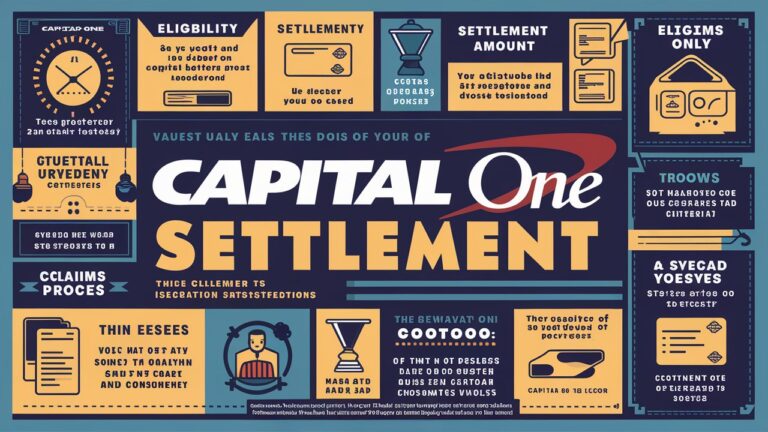Introduction
In 2019, Capital One Financial Corporation faced one of the largest data breaches in U.S. history, exposing the personal information of over 100 million customers. The fallout led to a landmark class-action lawsuit and a $190 million settlement approved in 2021. This article delves into the intricacies of the Capital One settlement, breaking down its implications, eligibility criteria, compensation details, and the broader lessons for cybersecurity. Whether you’re a victim of the breach or a consumer concerned about data privacy, this guide provides a comprehensive overview of the case and its lasting impact.
1. The Capital One Data Breach: A Timeline of Events
The Capital One data breach occurred in July 2019 when a hacker exploited a misconfigured firewall in the company’s cloud infrastructure, accessing sensitive data including Social Security numbers, bank account details, and credit scores. The breach affected approximately 106 million individuals in the U.S. and Canada, raising urgent questions about third-party cloud security (Capital One used Amazon Web Services). Investigations revealed that the hacker, a former AWS employee, had also targeted other organizations, but Capital One bore the brunt of public scrutiny due to the scale of the exposure. This section explores the timeline of the breach, the vulnerabilities exploited, and the immediate steps taken by Capital One to mitigate harm.
2. The Class-Action Lawsuit and Settlement Agreement
Following the breach, affected customers filed a class-action lawsuit against Capital One, alleging negligence in safeguarding their data. In December 2021, a federal court approved a $190 million settlement to resolve claims. The settlement fund was allocated to cover cash payments for out-of-pocket losses, credit monitoring services, and legal fees. Notably, Capital One denied wrongdoing but agreed to the settlement to avoid protracted litigation. This section explains the legal arguments, the structure of the settlement, and how it compares to other data breach resolutions, such as the Equifax settlement.
3. Who Is Eligible for Compensation?
Eligibility for the Capital One settlement compensation was determined by whether individuals received a notification from Capital One about the breach. This included U.S. and Canadian residents whose personal information was compromised. Affected parties could claim up to $25,000 in reimbursement for documented losses (e.g., fraudulent charges, identity theft costs) and enroll in free credit monitoring services for three years. This section details the eligibility criteria, required documentation, and common pitfalls claimants faced when submitting their requests.
4. How to File a Claim: Step-by-Step Guide
The claims process for the Capital One data breach settlement required individuals to submit forms online or via mail by the deadline (initially September 30, 2022). Claimants needed to provide proof of identity, evidence of losses tied to the breach, and opt-in for credit monitoring. This section walks readers through the now-closed process, highlighting lessons for future settlements, such as the importance of acting promptly and retaining financial records.
5. Compensation Breakdown: What Victims Received
Under the settlement, victims could choose between two forms of compensation: (1) cash payments for up to
25,000inlossesor(2)freecreditmonitoringviaPangoGroup.Eventhosewithoutdirectfinancialharmcouldclaimupto10hoursoflosttimeat
25,000inlossesor(2)freecreditmonitoringviaPangoGroup.Eventhosewithoutdirectfinancialharmcouldclaimupto10hoursoflosttimeat25/hour for addressing the breach’s fallout. This section analyzes the adequacy of the compensation, compares it to other data breach payouts, and discusses critiques from consumer advocates who argued the settlement undervalued long-term risks of identity theft.
6. Capital One’s Post-Breach Cybersecurity Improvements
In the wake of the breach, Capital One invested heavily in enhanced cybersecurity measures, including hiring a Chief Information Security Officer, upgrading cloud security protocols, and conducting regular audits. The company also committed to annual third-party security assessments. This section evaluates whether these changes sufficiently address the root causes of the breach and how they set a precedent for corporate accountability in data protection.
7. Lessons for Consumers: Protecting Your Data
The Capital One settlement underscores the importance of proactive data protection for consumers. Key takeaways include monitoring credit reports, freezing credit files, and using identity theft protection services. This section offers actionable advice for safeguarding personal information in an era of frequent cyberattacks, emphasizing the role of two-factor authentication and secure password practices.
8. Frequently Asked Questions (FAQs)
Q1: Am I still eligible to claim compensation from the Capital One settlement?
A: The claims deadline has passed, but eligible individuals who submitted claims should have received payments by mid-2023.
Q2: What if I didn’t receive a notification but believe I was affected?
A: Capital One notified all verified victims. If you suspect an error, contact the settlement administrator or check your spam folder for past communications.
Q3: How does the Capital One settlement compare to the Equifax settlement?
A: Equifax’s 2017 breach settlement was larger ($700 million) but covered more severe long-term risks. Both emphasized cash payouts and credit monitoring.
Q4: Can I sue Capital One separately if I missed the settlement deadline?
A: No. By accepting the settlement, claimants waived the right to pursue individual lawsuits.
Q5: What cybersecurity changes has Capital One implemented since 2019?
A: The company now uses advanced encryption, conducts routine penetration testing, and restricts third-party access to sensitive data.
Conclusion
The Capital One settlement serves as a critical case study in corporate accountability and consumer rights in the digital age. While the $190 million resolution provided relief to many, it also highlighted systemic vulnerabilities in cloud security and the need for stricter regulatory oversight. For consumers, the breach is a stark reminder to vigilantly guard personal data. As cyber threats evolve, both corporations and individuals must prioritize proactive measures to prevent future breaches.
This article provides a thorough examination of the Capital One settlement, equipping readers with the knowledge to navigate similar situations and advocate for stronger data protections.
